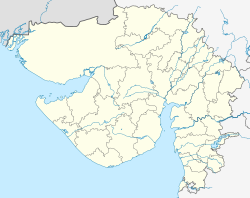Visnagar
This article may need to be rewritten to comply with Wikipedia's quality standards. (September 2017) |
Visnagar
Copper city | |
|---|---|
city | |
| Coordinates: 23°42′N 72°33′E / 23.7°N 72.55°E | |
| Country | India |
| State | Gujarat |
| District | Mehsana |
| Founded by | King Vishaldeo |
| Government | |
| • Type | Municipality |
| • Body | Nagar Palika |
| Elevation | 117 m (384 ft) |
| Population (2011) | |
| • Total | 63,073 |
| Languages | |
| • Official | Gujarati, Hindi |
| Time zone | UTC+5:30 (IST) |
| PIN | 384315 |
| Telephone code | 02765 |
| Vehicle registration | GJ-2- |
| Website | www |
Visnagar is a city and a municipality in Mehsana district in the Indian state of Gujarat.
History
"Visnagar" named after its founder king Visaladeva from Ajmer Dynasty was founded in 953 on the auspicious day of 'Akhatrij'.[citation needed]
Founded just as an outpost of the kingdom of king Visaldeo surrounding the present 'Deliya Talao' a huge water tank covering area of approx 2 lac sq. meter. As it was falling on a very strategic geographical location, Visnagar faced many war fights between Visaldeo, babis, ider dynasty and Gayakwads with change of rulers Visnagar so many changes and it grew with a fort wall with 6 gates none of them is present at this time but at some places, remains can be seen.
Visnagar Kasba Under Gayakwad rule, Visnagar become first town in North Gujarat to have underground water supply and sewerage system, Railway was also brought glory with it for the development of Visnagar with electricity.
Visnagar produced many freedom fighters during the time of British Rule. Noted teachers, painters, drama artists, writers were also among those who highlighted Visnagar.
Education facilities were instrumental in getting awareness among people. Nearly 29 schools of which two are for girls only and 7 colleges attract students and people outside Visnagar for years. Visnagar City Industrial establishments like submersible pumps, thrashers, diamonds and copper vessels drew attention nationwide.
Present population of Visnagar is 65,826 and majority is of Hindus. Industrial development, real estate development, education facilities and medical Facilities attract people from surrounding villages to come and stay here.
Geography
Visnagar is located at 23°42′N 72°33′E / 23.7°N 72.55°E. It has an average elevation of 117 metres (383 feet).
Earlier Visngagar was known as "Copper City" because there were so many workers who used to make pots from copper. It also has a big garden called "Doshabhai Garden". It is considered as one of the major commercial centre of Mehsana district. Visnagar is surround by many great places with religious and architectural importance like Ambaji (96 km), Mahudi (34 km), Patan (52 km), Modhera (44 km), Taranga (50 km) and Vadnagar. One can reach Visnagar by train from Mehsana (20 km) nearest airport is at Ahmedabad (80 km).
Demographics
As of 2001[update] India census,Visnagar had a population of 68,826. Males constitute 53% of the population and females 47%. Visnagar has an average literacy rate of 77%, higher than the national average of 59.5%: male literacy is 82%, and female literacy is 71%,
Education
Schools
- Adarsh Vidhyalay, Visnagar
- G.D.High School
- Kanya Sala, Visnagar
- Modern English School, Visnagar
- N.M. Nootan Sarva Vidyalaya, Visnagar
- Navyug Shisuniketan, Visnagar
- Prakash Vidyalaya, Visnagar
- Sardar Patel High School,Visnagar
- School of Victors, Visnagar
- Shri Sahajanand School, Visnagar
Universities
Hospitals
- Gokul orthopedic hospital
- Aakash Eye Hospital
- Siddhivinayak Hospital
- MIMS Hospital
- Himani Hospital
- Sardar Patel Hospital
- Jyoti Nursing Home
- Upasna Hospital
- Narsinhbhai Patel Dental College & Hospital
- Ridham Hospital for Women
- Amee Hospital

